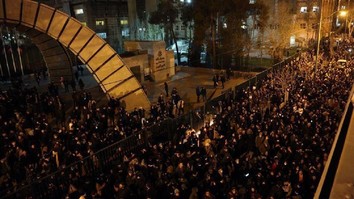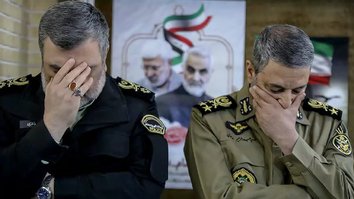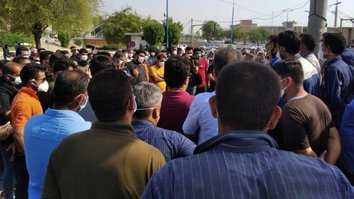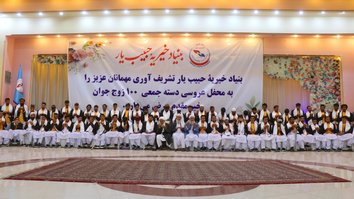Faced with an increasingly disaffected population and a tailspinning economy, Iranian leaders are scrambling to maintain control while at the same time posturing to appear tough against the West.
In an attempt to tamp down the unrest, Supreme Leader Ayatollah Ali Khamenei last Friday delivered a sermon in Tehran for the first time since 2012.
Instead of addressing the core issues affecting Iranians, Khamenei repeatedly tried to redirect his speech toward the January 3 killing of Iran's Islamic Revolutionary Guard Corps Quds Force (IRGC-QF) commander Maj. Gen. Qasem Soleimani.
After the killing of Soleimani, the Iranian regime -- for about a week -- was able to turn the tide and rally government support and anti-Western sentiment among the people.
![Iran's Supreme Leader Ali Khamenei failed to address the core sources of internal unrest during his speech on January 17, and instead attempted to whip up anti-West sentiment. [Office of the Supreme Leader]](/cnmi_st/images/2020/01/22/22054-khamenei__1_-585_329.jpg)
Iran's Supreme Leader Ali Khamenei failed to address the core sources of internal unrest during his speech on January 17, and instead attempted to whip up anti-West sentiment. [Office of the Supreme Leader]
![A telling image. While Iranian President Hassan Rouhani wasa addressing the Iranian regime's effort on improving the economy last week, two young girls living in squalor ran behind where he was speaking. [File]](/cnmi_st/images/2020/01/22/22053-poverty-585_329.jpg)
A telling image. While Iranian President Hassan Rouhani wasa addressing the Iranian regime's effort on improving the economy last week, two young girls living in squalor ran behind where he was speaking. [File]
That sentiment quickly turned again, however, when Tehran admitted -- three days after the fact -- that the IRGC had accidentally shot down a Ukrainian airliner on January 8.
That admission, and knowledge that the IRGC and top Iranian officials lied about the event in an attempted cover-up, set in motion renewed public outrage and unprecedented protests throughout Iran.
Tens of thousands of protesters took to the streets, shouting "Death to the dictator" -- a reference to Khamenei -- "Death to liars" and other anti-regime slogans.
Ignoring the protesters
But Khamenei's attempts to regain support left some Iranians even more outraged.
"He didn't even try to calm the people and totally ignored the protesters," one activist in Iran told AFP.
Like other Iranians contacted by AFP from outside the country, she asked to remain anonymous for fear of repercussions.
"He openly declared that Qasem Soleimani was more important than the passengers of the Ukrainian plane," she said.
An Iranian surface-to-air missile took down the plane in a "catastrophic mistake" by Tehran's air defence crews.
All 176 passengers and crew were killed including 82 Iranians, 63 Canadians, 11 Ukrainians, 10 Swedes, four Afghans, three Germans and three Britons.
Another Iranian responded to the speech via the Telegram messenger app, saying Khamenei "said bluntly... the dead, whether on the ground or in the sky, are not important to me".
Khamenei also said the protesters were not representative of Iran.
"When he says these people are not one of us, it deepens divisions among people and widens the distance between the people and the government," a 24-year-old artist in Tehran told AFP.
"And it makes someone like myself, who is not close to the regime, seek change even more aggressively," he said.
Persistent economic woes
Khamenei's speech ignored the source of the Iranian people's distress and dissatisfaction.
While the latest demonstrations were sparked by Iran's downing of the airliner and the perceived incompetence of Iranian leaders to manage the incident, there is an undercurrent of rage directed at Iran's persistent economic woes.
Inflation is close to 40%, according to the Statistical Centre of Iran, saddling consumers with high prices of food and other basic necessities. Unemployment among youth aged 15-24 years is over 28%, according to the World Bank.
Those conditions threaten to worsen as Britain, France and Germany on January 14 launched a dispute mechanism under a 2015 nuclear deal with the Iranian regime after accusing Tehran of repeated violations.
Iran's non-compliance with the deal -- known as the Joint Comprehensive Plan of Action (JCPOA) -- is what pushed the US government to withdraw from the agreement and levy sanctions against Tehran in 2018, according to US authorities.
Since May 2019, Iran has progressively scaled back some commitments under the agreement in response to the US sanctions and Europe's inability to circumvent them.
Economic unrest
While the Iranian regime is quick to blame the United States for its economic problems, the Iranian people are becoming increasingly emboldened to question their own government's policies.
A shock decision to impose petrol price hikes by as much as 200% sparked nationwide demonstrations on November 15.
Between 120,000 and 200,000 people took part in the protests, according to Iranian government estimates.
While those protests stemmed from the petrol price increase, the scale of the unrest points to deep-rooted economic problems -- from the debt-ridden banking sector to the outsized and opaque role of military-linked organisations in the economy.
Many Iranians say the regime is exacerbating the economic problems of its own people by choosing to support proxy wars around the region -- particularly in Syria, Iraq and Yemen -- instead of investing in its own country.
The regime's violent crackdown on protesters, journalists, human rights activists and students in the wake of the November demonstrations proved only to exacerbate people's anxieties rather than silence their concerns.
Harsh words, minimal revenge
These economic troubles and the internal unrest caused by them may be tempering the Iranian regime's willingness to confront the West in the latest showdown.
Initially after the killing of Soleimani, Khamenei, President Hassan Rouhani, and a number of other top Iranian officials warned of "severe revenge" against the United States.
That "revenge" came in the form of 22 missiles launched against US bases in Iraq on January 8.
Iranian authorities claimed 80 US troops were killed in the attack. In reality, the attack inflicted minor material damages and 11 US troops were treated for injuries after the fact, according to the Pentagon.
Realising their inability to face off against Western powers, Iranian leaders began to walk back on their previous braggadocio.
"Our aim was not really to kill enemy soldiers. That was not important," IRGC top commander Hossein Salami told parliament January 12.
The need for Iranian leaders to go to such lengths to exaggerate the regime's capabilities and the timidity of the military's "severe vengeance" have exposed major weaknesses in Iran's clerical and military establishments.
Rouhani on January 16 said Iran was "working daily to prevent military confrontation or war", and maintained that a dialogue with the world was still "possible".
Whether the Iranian regime is willing to engage in dialogue with the Iranian people and listen to their demands remains to be seen.







